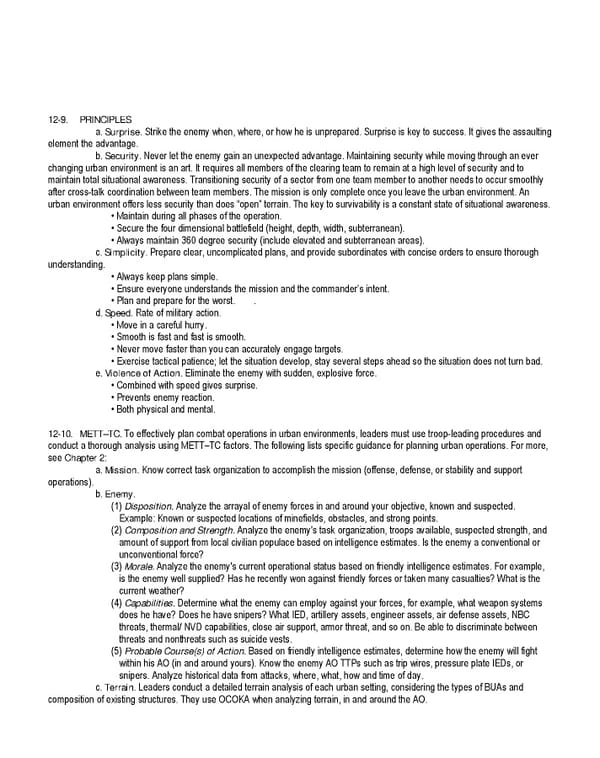12-9. PRINCIPLES a. Surprise. Strike the enemy when, where, or how he is unprepared. Surprise is key to success. It gives the assaulting element the advantage. b. Security. Never let the enemy gain an unexpected advantage. Maintaining security while moving through an ever changing urban environment is an art. It requires all members of the clearing team to remain at a high level of security and to maintain total situational awareness. Transitioning security of a sector from one team member to another needs to occur smoothly after cross-talk coordination between team members. The mission is only complete once you leave the urban environment. An urban environment offers less security than does “open” terrain. The key to survivability is a constant state of situational awareness. • Maintain during all phases of the operation. • Secure the four dimensional battlefield (height, depth, width, subterranean). • Always maintain 360 degree security (include elevated and subterranean areas). c. Simplicity. Prepare clear, uncomplicated plans, and provide subordinates with concise orders to ensure thorough understanding. • Always keep plans simple. • Ensure everyone understands the mission and the commander’s intent. • Plan and prepare for the worst. . d. Speed. Rate of military action. • Move in a careful hurry. • Smooth is fast and fast is smooth. • Never move faster than you can accurately engage targets. • Exercise tactical patience; let the situation develop, stay several steps ahead so the situation does not turn bad. e. Violence of Action. Eliminate the enemy with sudden, explosive force. • Combined with speed gives surprise. • Prevents enemy reaction. • Both physical and mental. 12-10. METT–TC. To effectively plan combat operations in urban environments, leaders must use troop-leading procedures and conduct a thorough analysis using METT–TC factors. The following lists specific guidance for planning urban operations. For more, see Chapter 2: a. Mission. Know correct task organization to accomplish the mission (offense, defense, or stability and support operations). b. Enemy. (1) Disposition. Analyze the arrayal of enemy forces in and around your objective, known and suspected. Example: Known or suspected locations of minefields, obstacles, and strong points. (2) Composition and Strength. Analyze the enemy's task organization, troops available, suspected strength, and amount of support from local civilian populace based on intelligence estimates. Is the enemy a conventional or unconventional force? (3) Morale. Analyze the enemy's current operational status based on friendly intelligence estimates. For example, is the enemy well supplied? Has he recently won against friendly forces or taken many casualties? What is the current weather? (4) Capabilities. Determine what the enemy can employ against your forces, for example, what weapon systems does he have? Does he have snipers? What IED, artillery assets, engineer assets, air defense assets, NBC threats, thermal/ NVD capabilities, close air support, armor threat, and so on. Be able to discriminate between threats and nonthreats such as suicide vests. (5) Probable Course(s) of Action. Based on friendly intelligence estimates, determine how the enemy will fight within his AO (in and around yours). Know the enemy AO TTPs such as trip wires, pressure plate IEDs, or snipers. Analyze historical data from attacks, where, what, how and time of day. c. Terrain. Leaders conduct a detailed terrain analysis of each urban setting, considering the types of BUAs and composition of existing structures. They use OCOKA when analyzing terrain, in and around the AO.
 Ranger Handbook Page 227 Page 229
Ranger Handbook Page 227 Page 229